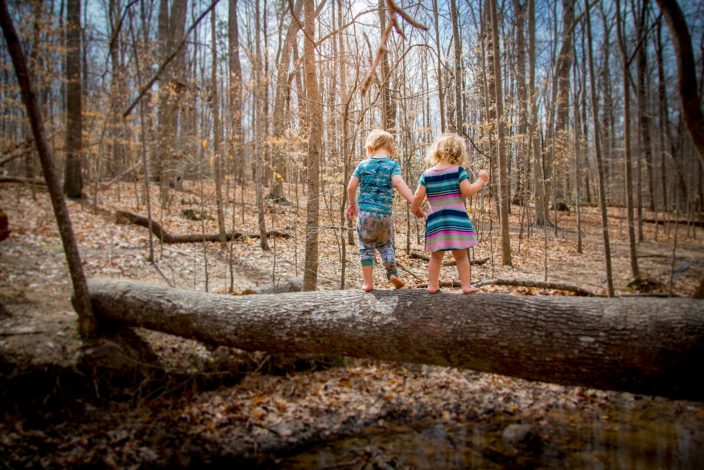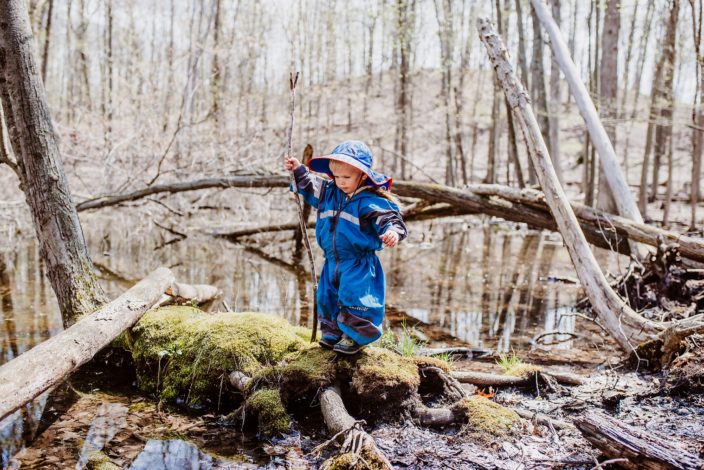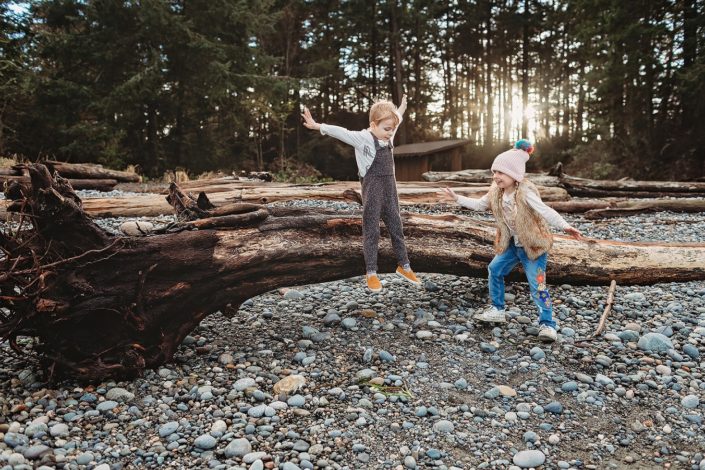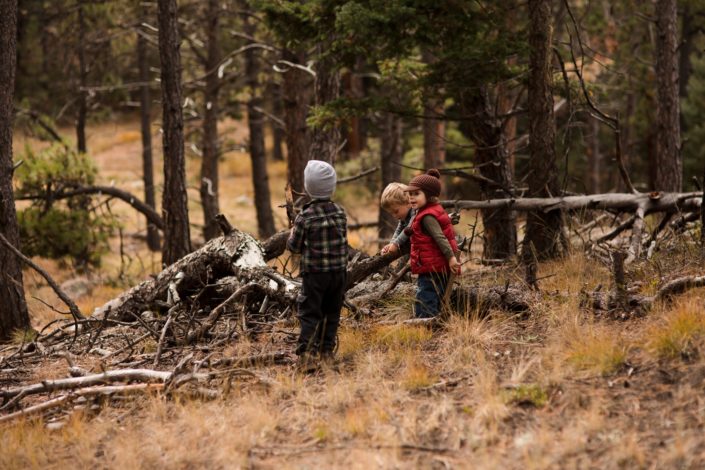The Do’s and Don’ts of Risky Play
- Blog The Do’s and Don’ts of Risky Play

The habits we form from childhood make no small difference, but rather they make all the difference. —Aristotle
We spend much of our lives doing our best to keep our children safe. We bundle them up when it’s cold. We feed them healthy foods. We put plug covers in the electrical outlets. We put child safety locks on all the cabinets. We buckle them safely into their car seats. So, why in the world would we ever allow our precious little ones to take any sort of risk that could get them injured? That seems crazy, right? Maybe not.
When children are allowed to participate in risky play, it challenges their bodies in new ways. It develops strong muscles and organizes the senses, which increases their cognitive development. For instance, going upside down moves the fluid in the inner ears and helps improve spatial awareness. Spinning in circles improves balance and attention. And climbing to high heights advances children’s motor skills and promotes a sense of self-confidence and accomplishment. I will never forget the time when my oldest son, Neko, conquered a 30-foot tree and proclaimed, “I am the king of all of the earth!” He walked taller that day.
Over time, our definition of risk-taking changes. As a teenager, standing up to a bully or going against peer pressure would be considered a risk. And as adults, climbing a tree is no longer exhilarating, but perhaps changing jobs and getting married is a big risk. Allowing our children to take these chances today — in a safe, supportive environment — allows them to practice these skills for more important life decisions as they get older. 
Hazards vs. Risks
In my “other life,” outside of Hike it Baby, I am an Administrative Director at a preschool where we encourage risky play. We get tons of questions and concerns from parents about risky play. We always start out with addressing the difference between “Hazard” and “Risk.” Risks are situations with the possibility of being dangerous, while hazards are situations that are inherently dangerous.
So what exactly is risky play?
Risky play is defined as play that provides opportunities for challenges, testing limits, exploring boundaries, encountering uncertainty and learning about injury risk. Walking, running, climbing and riding a bike require negotiation with injury risks. If a child isn't willing to get hurt, they can't acquire these skills as readily, if at all! Ellen Sandseter, a professor at Queen Maud University in Trondheim, Norway, has identified six categories of risky play.
- High heights: Children climb trees and other structures and gain a birds-eye view of the world and the thrilling feeling of “I did it!”
- Rapid speeds: Children swing on vines, ropes or playground swings; slide on sleds, skis, skates or playground slides; and ride bikes, skateboards and other devices fast enough to produce the thrill of almost, but not quite, losing control.
- Dangerous tools: Depending on the culture, children play with knives, bows and arrows, farm machinery or other tools. There is, of course, great satisfaction in being trusted to handle such tools, but there is also thrill in controlling them.
- Dangerous elements: Children love to play with fire or in and around deep bodies of water — either of which poses some danger. Even playing with sticks could be considered a dangerous element.
- Rough and tumble: Children everywhere chase one another around and fight playfully. Kids nearly always prefer being in the most vulnerable position: the one being chased or the one underneath in wrestling, which involves the most risk of being hurt and requires the most skill to overcome.
- Disappearing/getting lost: Who doesn’t love a game of hide-and-seek? Children experience the thrill of temporary separation from their companions. Older kiddos venture off on their own away from adults into territories that, to them, are filled with imagined dangers.

Do’s and Don’ts of Risky Play
Don’t help your child. OK, OK, I know that sounds heartless, but hear me out. If you help your child up the tree, they aren’t doing it themselves. There is no sense of accomplishment for them and it can potentially be dangerous. If they can’t climb the tree, then that means they shouldn’t be up there!
- Don’t force your child to participate in risky play. Each child knows their limits and you should respect them.
- Don’t say “Be careful.” My go-to phrase is, “Are you feeling safe? What is your plan?” If they can tell me what their plan is, I know that they are thinking critically about their decisions. They are more “present” in their play, which will prevent injury. Amanda, from Hike it Baby Park City, UT, reminds her child to “trust your body.” Teaching a child to listen to his body is an invaluable skill as he gets older!
- Don’t panic. It can be scary to watch your child participate in dangerous activities. Your heart races and you feel nervous. You start to think of all the horrible things that are going to happen and how much the hospital bill will be. Children will feed off of that energy. If you are scared, they will then believe that what they are doing is scary and, as a result, panic, as well.
- Don’t come to your child’s rescue if they are “stuck.” I’m such a mean mom, right? If your child is stuck, your first reaction will likely be to swoop in and rescue them. Instead, talk them through it. Did they climb up a play structure and they can’t get down? Talk them through it: “It looks like you’re scared. Let me help you. Put your foot there. OK, now put your hand there. You can do it.”
- Don’t let the “haters” discourage you. It can be frustrating when a stranger on the playground helps your child off the play structure, or when they tell you that your 2-year-old is climbing up a ladder (yeah, I know, lady, I’m sitting here watching him), but take it as an opportunity to educate people on risky play. Tell them that you trust your child’s decisions and that they know their limits better than anyone else.
- Do be present. Talk them through their play if there is an exceptional risk. Make them aware of what they are doing. “You are up there so high! You are so brave. I see you stepping so carefully.”
- Do expose your child to risky play opportunities frequently. Even if they don’t take to risky play right away, it’s important to expose them to the opportunity. You never know when they will finally be ready to tackle those monkey bars!
- Do allow children to play with sticks. Sticks are my 10-month-old's favorite toy. (Don’t worry, they don’t have sharp ends, so they are not a hazard.) Sticks can be anything. It can be a wand, it can be a log, it can be a chew toy, it can be a writing utensil, it can be a tool. Sticks open up a child’s imagination!
- Do allow your child to go up the slide. This may be an unpopular statement, but I assure you, it’s actually good for kids — taking turns, communication (“Is anyone at the top? I want to climb up!), and using a new set of muscles. (But do make sure they aren't preventing other kids from sliding down.) Don’t take fun and adventure away at the playground!
- Do allow your child to explore on their own. Be close enough to talk to them, but don’t follow too closely. This will create more independence and self-confidence in their ability to participate in risky play opportunities.
- Do allow them to fail. Failing is how children learn! It’s OK if they get “stuck” in the tree. It’s OK if they fall of the log while they are balancing. And, above all else, don’t panic if they do!
- Do trust your child. They know their limits. If they weren’t ready for something, they wouldn’t do it.
 I realize that risky play may not be for every family. However, in my decade of working in early childhood education, I have seen many more benefits than disadvantages of risky play. I’ve seen shy children come out of their shell when they finally tackled something they were too scared to do. I’ve seen childhood friendships develop by just building a fort. And I’ve seen my own son’s self-confidence soar over the years as he tackled more challenging activities. We’ve always allowed him to be his authentic Wild Child Self, and you know what? We’ve never been to the emergency room (*knock on wood*!).
I realize that risky play may not be for every family. However, in my decade of working in early childhood education, I have seen many more benefits than disadvantages of risky play. I’ve seen shy children come out of their shell when they finally tackled something they were too scared to do. I’ve seen childhood friendships develop by just building a fort. And I’ve seen my own son’s self-confidence soar over the years as he tackled more challenging activities. We’ve always allowed him to be his authentic Wild Child Self, and you know what? We’ve never been to the emergency room (*knock on wood*!).
What are your tips for encouraging other families who may be feeling unsure about risky play? Please share with us in the comments below.
Read more:
- Resist fear and embrace resilience: Kids and risk in the outdoors
- Dr. Scott: Raise a child with Hike it Baby
- 3 Trail safety tips you must know
- Nature babies: Why having young kids in nature is so important for their health
Photos by Stephanie Jacobson, Amy Diebold, Anastasia Novosyolova and Krystal Weir.
ABOUT OUTGROWN
OutGrown is a 501(c)(3) nonprofit that works to create a world where everyone can enjoy the physical and mental benefits of spending time outside. We are focused on creating opportunities and removing barriers to access so families with babies and young children can take their first steps outside. We believe all families have the right to connect with nature, benefit from spending time outdoors and be inspired to a lifelong love of nature. Since its grassroots inception in 2013, OutGrown is a growing community of 280,000 families and over 300 volunteer Branch Ambassadors. More information on all of our programs can be found at WeAreOutGrown.org
EDITORS NOTE:
We hope you enjoyed reading this article from OutGrown. We’re working hard to provide our community with content and resources that inform, inspire, and entertain you.
But content is not free. It’s built on the hard work and dedication of writers, editors, and volunteers. We make an investment in developing premium content to make it easier for families with young children to connect with nature and each other. We do not ask this lightly, but if you can, please make a contribution and help us extend our reach.
Related Content




Comments